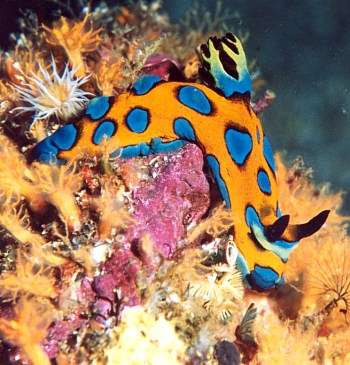Tambja verconis? from NZ
December 3, 1999
From: Daphne & Graham Climie


Dear Dr Rudman,
Please find enclosed prints copied from slides of our mystery nudibranch. It was seen
at the Poor Knights Islands off the east coast of Northland, New Zealand on 6 Oct 1999 at 50 feet. It measures approximately 8 cms in length. We have never seen this species before and have dived regularly in this area for 30 years. The water here is unusually warm this year and many unusual species have been recorded in the last 2 years which have never been seen here previously. We saw Glaucus atlanticus last Summer. Other Tambja species previously recorded here are present in unusually high numbers this Spring.
We are most grateful for your interest and help.
Yours sincerely,
Daphne & Graham Climie
Whangarei,
New Zealand.

Dear Daphne & Graham,
It is certainly a spectacular animal and at 8 cms must have been quite a sight.
My first thought was I had seen nothing like it, but on reflection it is quite similar to Tambja verconis. There are photos of T. verconis on the Forum from the Poor Knights. If it is a peculiar colour form of T. verconis I must say I have never seen one like it.
Is it a Tambja, Nembrotha or Robastra?
The only sure way I could tell you what genus it belongs to and whether it has any relationship to Tambja verconis would be for me to dissect it and check out its anatomy. Failing that there are a couple of external clues I can use.
If you look at the photo of its head (lower right) you will see a blue 'lappet' or grooved ridge on either side of the head, which I assume is sensory. Similar structures are found in other species of Nembrotha and Tambja while in the genus Robastra, which hunts and eats other nudibranchs, there are a pair of long prominent tentacles flanking the mouth which can be seen in my reply to one of Ross Armstrong's messages about Roboastra luteolineata.
The second clue is the other photo (upper right) which shows the head of your animal in very close proximity to a half-eaten colony of the bluish arborescent bryozoan that Tambja verconis feeds on. I can't guarantee that it was feeding on the bryozoan, but it is a strong possibility that your animal is a species of Tambja. I can't be sure of its relationship to T. verconis without looking at its anatomy. Failing collecting a specimen, I guess I don't need to say that it would be worthwhile keeping an eye out for more specimens, and see if you can find any colour variation.
Glad to see the prints, and if you have any more of other species I would be glad to include them on the Forum.
Best wishes,
Bill Rudman.
Related messages
-
Tambja cf. verconis from sthn Queensland
From: Ian Banks, April 15, 2006 -
Tambja cf. verconis from South Korea
From: Dong Bum Koh, June 11, 2005 -
Tambja cf. verconis from Korea
From: Dong Bum, Koh, October 19, 2002 -
Tambja cf. sagamiana from Sth Korea
From: Dong Bum, Koh, July 12, 2002
